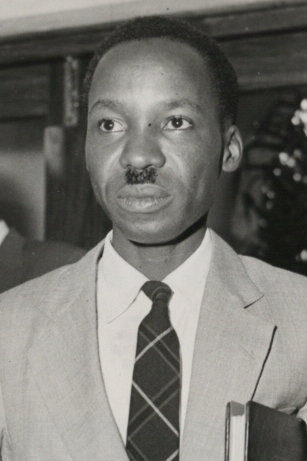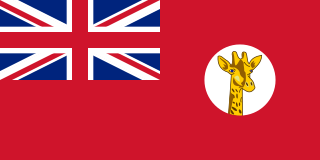Related Research Articles
The African Great Lakes nation of Tanzania dates formally from 1964, when it was formed out of the union of the much larger mainland territory of Tanganyika and the coastal archipelago of Zanzibar. The former was a colony and part of German East Africa from the 1880s to 1919’s when, under the League of Nations, it became a British mandate. It served as a British military outpost during World War II, providing financial help, munitions, and soldiers. In 1947, Tanganyika became a United Nations Trust Territory under British administration, a status it kept until its independence in 1961. The island of Zanzibar thrived as a trading hub, successively controlled by the Portuguese, the Sultanate of Oman, and then as a British protectorate by the end of the nineteenth century.

Tanganyika was a sovereign state, comprising the mainland part of present-day Tanzania, that existed from 1961 until 1964. It first gained independence from the United Kingdom on 9 December 1961 as a state headed by Queen Elizabeth II before becoming a republic within the Commonwealth of Nations a year later. After signing the Articles of Union on 22 April 1964 and passing an Act of Union on 25 April, Tanganyika officially joined with the People's Republic of Zanzibar to form the United Republic of Tanganyika and Zanzibar on Union Day, 26 April 1964. The new state changed its name to the United Republic of Tanzania within a year.

Julius Kambarage Nyerere was a Tanzanian anti-colonial activist, politician, and political theorist. He governed Tanganyika as prime minister from 1961 to 1962 and then as president from 1962 to 1964, after which he led its successor state, Tanzania, as president from 1964 to 1985. He was a founding member and chair of the Tanganyika African National Union (TANU) party, and of its successor Chama Cha Mapinduzi, from 1954 to 1990. Ideologically an African nationalist and African socialist, he promoted a political philosophy known as Ujamaa.

The flag of Tanzania consists of a yellow-edged black diagonal band, divided diagonally from the lower hoist-side corner, with a green upper triangle and light blue lower triangle. Adopted in 1964 to replace the individual flags of Tanganyika and Zanzibar, it has been the flag of the United Republic of Tanzania since the two states merged that year. The design of the present flag incorporates the elements from the two former flags. It is one of a relatively small number of national flags incorporating a diagonal line, with other examples including the DR Congo, Namibia, Trinidad and Tobago and Brunei.

The Tanganyika African National Union (TANU) was the principal political party in the struggle for sovereignty in the East African state of Tanganyika. The party was formed from the Tanganyika African Association by Julius Nyerere in July 1954 when he was teaching at St. Francis' College. From 1964 the party was called the Tanzania African National Union. In January 1977 the TANU merged with the ruling party in Zanzibar, the Afro-Shirazi Party (ASP), to form the current Revolutionary State Party or Chama Cha Mapinduzi (CCM). The policy of TANU was to build and maintain a socialist state aiming towards economic self-sufficiency and to eradicate corruption and exploitation, with the major means of production and exchange under the control of the peasants and workers.

The National Assembly of Tanzania and the President of Tanzania of the United Republic make up the Parliament of Tanzania. The current Speaker of the National Assembly is Tulia Ackson, who presides over a unicameral assembly of 393 members.

Ujamaa was a socialist ideology that formed the basis of Julius Nyerere's social and economic development policies in Tanzania after it gained independence from Britain in 1961.
Godfrey Mwakikagile is a prominent Tanzanian scholar and author specialising in African studies. He was also a news reporter for The Standard — the oldest and largest English newspaper in Tanzania and one of the three largest in East Africa.

Oscar Salathiel Kambona (1925-1997) was the first Minister of Foreign Affairs of Tanganyika. He was arguably the second-most influential and most popular leader in the country after President Julius Nyerere.

Tanganyika was a colonial territory in East Africa which was administered by the United Kingdom in various guises from 1916 to 1961. It was initially administered under a military occupation regime. From 20 July 1922, it was formalised into a League of Nations mandate under British rule. From 1946, it was administered by the UK as a United Nations trust territory.
Sir Richard Gordon Turnbull, GCMG was a British colonial governor and the last governor of the British mandate of Tanganyika from 1958 to 1961. Following the country's independence, he was governor-general from 9 December 1961 to 9 December 1962.
General elections were held for the first time in the newly formed Union of Tanzania in September 1965. The country had also just become a one-party state, with the Tanganyika African National Union as the sole legal party on the mainland, and the Afro-Shirazi Party was the only party in Zanzibar. For the National Assembly election there were two candidates from the same party in each constituency, whilst the presidential election was effectively a referendum on TANU leader Julius Nyerere's candidacy.
General elections were held in Tanzania on 26 October 1975. The country was a one-party state at the time, with the Tanganyika African National Union as the sole legal party on the mainland, and the Afro-Shirazi Party was the only party in Zanzibar. For the National Assembly election there were two candidates from the same party in each of the constituencies, whilst the presidential election was effectively a referendum on TANU leader Julius Nyerere's candidacy.
The Constitution of Tanzania, formally Constitution of the United Republic of Tanzania and also known as Permanent Constitution or Fourth Constitution of Tanzania, was ratified in 1977. Before the current establishment, Tanzania has had three constitutions: the Independence Constitution, the Republican Constitution (1962), and the Interim Constitution of the United Republic of Tanganyika and Zanzibar (1964).

The Chama Cha Mapinduzi is the dominant ruling party in Tanzania and the second longest-ruling party in Africa, only after the True Whig Party of Liberia. It was formed in 1977, following the merger of the Tanganyika African National Union (TANU) and the Afro-Shirazi Party (ASP), which were the sole operating parties in mainland Tanzania and the semi-autonomous islands of Zanzibar respectively.
John Mwakangale was one of the main leaders in the struggle for independence in Tanganyika during British colonial rule. When the country gained independence, Mwakangale joined the first cabinet of Julius Nyerere, the first President of Tanzania as Minister of Labour. Mwakangale is also regarded as a Pan-Africanist and a staunch African nationalist. He was also the first leader whom Nelson Mandela met in 1962 when he escaped from prison seeking assistance from other African leaders. Mandela gave a detail account about that encounter in his book Long Walk to Freedom.
Jeremiah Kasambala was one of the first ministers in the cabinet of Julius Nyerere after Tanganyika won independence from Britain on 9 December 1961. He rose to prominence when he was the head of the Rungwe African Cooperative Union in Rungwe District in the Southern Highlands Province.
Vedastus Kyalakishaija Kyaruzi (1921-2012) was a Tanzanian diplomat and politician.

Lucy Lameck was a Tanzanian politician, who was the first woman to hold a Ministerial post in the government. Born to a farming family, she trained as a nurse before becoming involved in politics and attending Ruskin College, Oxford, through a scholarship. She first entered the Tanganyika National Assembly in 1960, before being elected to the Tanzania National Assembly in 1965. With the exception of 1975 to 1980, she continued to hold a seat there until her death in 1993. She is seen as a role model, having worked throughout her life to improve conditions within the country for women.

Bibi Titi Mohammed was a Tanzanian politician of Muslim descent. She was born in June 1926 in Dar es Salaam, at the time the capital of former Tanganyika. She first was considered a freedom fighter and supported the first president of Tanzania, Julius Nyerere. Bibi Titi Mohammed was a member of the Tanganyika African National Union (TANU), the party that fought for the independence of Tanzania, and held various ministerial positions. In October 1969, she was sentenced for treason, and, after two years in prison, received a presidential pardon.
References
- 1 2 3 4 Hubbard, James P. (10 January 2014). The United States and the End of British Colonial Rule in Africa, 1941-1968. McFarland. p. 231. ISBN 978-0-7864-5745-8.
- ↑ Adam, Michel (22 October 2015). Indian Africa: Minorities of Indian-Pakistani Origin in Eastern Africa. Mkuki na Nyota Publishers. p. 373. ISBN 978-9987-08-297-1.
- ↑ Mwakikagile, Godfrey (2007). Nyerere and Africa: End of an Era. New Africa Press. p. 599. ISBN 978-0-9802534-1-2.
- ↑ Wykes, Alan (1961). Tanganyika: A Story of Progress. British Information Services. p. 40.
- ↑ Mattsson, Sven, Monö, Ralph. Facklig Horisont: Afrika. Lund: Bokförlaget Prisma, 1977. p. 60.
- ↑ "EISA Tanzania: Unregistered and defunct parties". www.eisa.org.za. 2017-07-17. Archived from the original on 2017-07-17. Retrieved 2021-10-22.
- ↑ Division, Great Britain Central Office of Information Reference (1961). Tanganyika. Reference Division, British Information Services. p. 8.